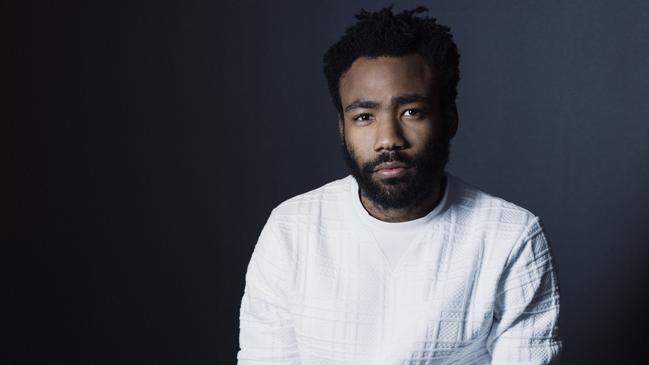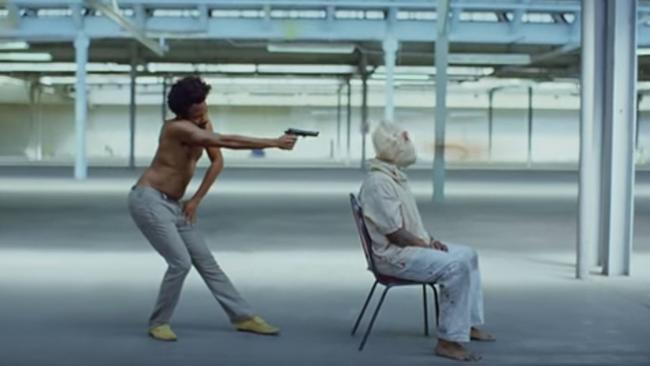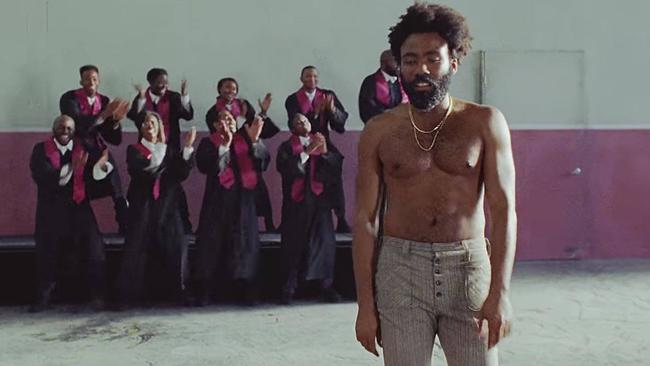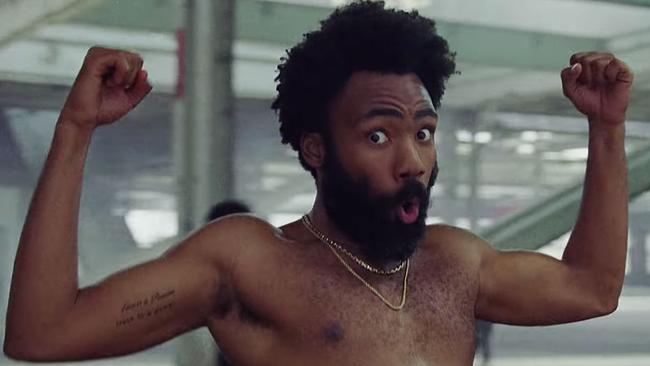Childish Gambino’s This Is America throws fresh light on race
Confrontation is bread and butter for Childish Gambino, aka actor, writer, director, musician and comedian Donald Glover.

It is not your usual rap video. In This is America a shirtless Childish Gambino, aka 34-year-old actor, writer, director, musician and comedian Donald Glover, sings “We just want to party” while dancing in a goofy fashion in a carpark next to a man with an acoustic guitar. Then the man becomes a hooded figure tied to a chair — who Glover shoots in the back of the head.
As the song unfolds, Glover leads smiling schoolchildren in African dance routines, guns down a gospel choir in echoes of the 2015 church killing in Charleston, South Carolina, and ends up running in terror from the police, looking alternately harmless and threatening throughout.
“It’s like when Obama became president and people said that racism was over,” Glover once said when I asked him about his situation as a middle-class rapper who doesn’t fit into hip-hop’s gangster cliche. “I have a lyric that I haven’t put out yet: ‘White kids like me, I rap about comics and stuff. White kids hate me, I don’t scare their parents enough.’
“I don’t use my black card so people don’t get hood tourism by listening to my music, but I do try to be honest to my situation and who I am.”
In the 10 days since it made its debut on Saturday Night Live, This is America has become a phenomenon. It has garnered more than 109 million YouTube views, alongside endless think pieces and some increasingly complex conspiracy theories. One (false) theory has it that the hooded figure is the father of Trayvon Martin, an unarmed black teenager killed by police in 2012.
A version of the video set to the harmless pop singer Carly Rae Jepsen’s fluffy hit Call Me Maybe became a minor trend before being vilified for making light of a portrait of a country in which internet dance crazes and horrific violence go hand-in-hand. Glover seems to be saying that black people being killed has become so commonplace that it is just another part of the entertainment industry.
Is it any good? The song begins with cheerful African chants, then segues with sudden shock into trap, the dark, synthesised variant on hip-hop that emerged from drug houses in 1990s Atlanta, just as Glover shoots a man in the video. From then on, This is America balances between joyful singing and manic, rather scary rapping from Glover and a host of guest stars, which the video mirrors through its blend of dance routines and extreme violence.
It is not a song you would want to listen to while unwinding after a hard day’s work. Lines such as “this is America, guns in my area” do not offer much in the way of escapism. But it is brilliant. Like the best art, the song and video are at once extremely simple — violence and entertainment go together, so here is some ominous rap and uplifting melody — and endlessly layered.
Glover has resisted the temptation to explain away the symbolism in This is America, leaving the rest of the internet to reveal the Jim Crow imagery in the way he dances and his comment on America’s obsession with guns in the respectful way he hands over a gun to a boy with a red cloth; it has been suggested that a white stallion seen briefly in the background represents the pale horse of the Apocalypse. It also marks a career high for a man who got his break writing for American sitcom 30 Rock, went on to write and star in the landmark comedy-drama series Atlanta, won five Grammy nominations this year and has bagged the film role that boyhood dreams are made of: Lando Calrissian in Solo: A Star Wars Story.
Glover grew up in the suburbs of Atlanta, Georgia, the eldest son of Jehovah’s Witnesses who fostered children from troubled backgrounds.

His father liked Prince and Funkadelic, while his mother, the head of the local foster parents’ association, owned two records: the soundtrack to the summer-camp comedy Meatballs and Elton John’s Candle in the Wind. He says he wasn’t encouraged to go into music. “That might be why I went into comedy first. I didn’t feel I had to ask permission to do it.”
While studying dramatic writing at New York University, where he was in the same year as Lady Gaga, Glover started DJing in his spare time, learning to rap over the beats-making computer program Fruity Loops before getting a gig writing for Tina Fey on 30 Rock in 2006. He also did stand-up. “I had no money. I was about to start a job writing for video games and I knew it was going to suck,” Glover said. “Tina Fey’s manager heard about me and got in contact, asked to see my writing, and Tina Fey interviewed me a few days later.”

Six days after leaving the 30 Rock team in 2009, Glover was cast as Troy, the high school football star turned lovable sidekick of the sitcom Community. It follows an unlikely group of friends studying at a community college in Colorado, and the show’s reassuring message about people from wildly diverse backgrounds all getting along did a good job of covering the realities of tensions on set. The show’s creator, Dan Harmon, has said that the relationship between co-star Chevy Chase and Glover was strained due to the latter’s rising star.
Glover left Community midway through season five and appeared in a couple of episodes of Girls as Sandy, the black Republican boyfriend of Lena Dunham’s character, Hannah. There is a telling scene in which he makes fun of Hannah’s New York ambitions: “Oh, I’ve got a fixed-gear bike, and I’m going to date a black guy and move to a dangerous part of town.”
With Childish Gambino, Glover up-ended the idea of what a black rapper should be like. He wore short shorts and a Mickey Mouse T-shirt, he rapped about being bullied at school and his breakthrough single, Redbone, from his 2016 psychedelic-soul album Awaken, My Love!, is a sultry slow jam. It featured in Get Out!, Jordan Peele’s horror comedy about a black man being consumed by the murderously liberal parents of his new white girlfriend. Then there is Atlanta.

“Atlanta is the best show on TV, period,” comedian Chris Rock told The New Yorker. The comedy is about four black friends facing up to life’s limitations. Initially, Glover’s insider observations on black life proved a challenge for mainstream television. When broadcaster FX expressed confusion that two of the characters, Earn and Vanessa, have a daughter, are not married and sleep together every now and then, Glover replied: “This is every one of my aunts. You have a kid with a guy, he’s around, you’re still attracted to him.”
Set in and around the city of the title, Atlanta follows down-on-his-luck Earnest “Earn” Marks, played by Glover, as he tries to manage his cousin Alfred’s burgeoning career as the rapper Paper Boi. Alfred’s conspiracy-theorist friend, Darius, completes the picture in a show that switches between light comedy and brutal reality, with race-related humour from the black perspective featuring heavily.
There is the “transracial” teenager Antoine, who is transitioning from a black teen from Atlanta into a 35-year old white man from Colorado, easing the procedure by playing golf, visiting farmers markets and developing a taste for craft beer.
It is tinged with surrealism, possibly because Glover and his crew smoke a lot of weed during filming. One of the most popular scenes features an alligator sauntering out of Earn’s uncle’s house in Florida to the tune of the Delfonics’ soul classic Hey! Love.
The show’s regular director, Hiro Murai, made the video for This is America and a lot of Atlanta flows into it: gallows humour, surrealism, fresh takes on news topics and the way being black in America can mean going from carefree joy to brutal violence in a flash. And, by playing the comic dancer and the manic killer in the video, Glover is owning up to his complicity in America’s tangled web of celebrity, show business and current affairs as entertainment.
Not everybody loves This is America. Journalist Joshua Adams writes on the rap site DJBooth: “How can (Glover) be critical of using dead black bodies to garner clicks when he’s using the very same tactic as a prop to make art?” In any case, This is America continues with something Glover has been doing since he first came into view: forcing us all to look at race in a fresh light.
“Hip-hop is not scary any more,” he said, when we spoke shortly before his career went into the stratosphere. “When a rapper goes, ‘I’m coming to your house and I’m going to shoot your whole family’, people like it because it obviously won’t happen and anyway we’ve heard it all before. What I’m saying is: ‘I’m going to date your white daughter, and we have a gay friend.’ Now that’s really scary.”
THE TIMES



To join the conversation, please log in. Don't have an account? Register
Join the conversation, you are commenting as Logout